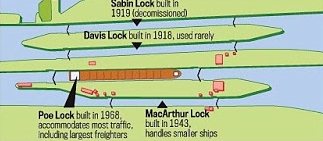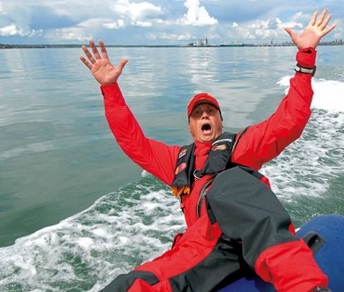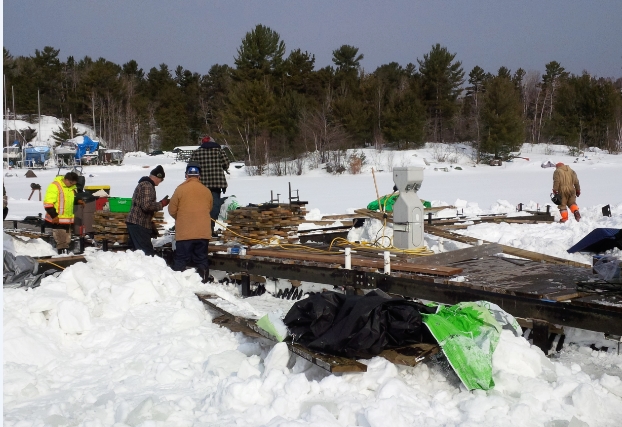| Back to Back Issues Page |
 |
|
Rhumb Line, Vol 4 Issue 2 -- New at www.great-lakes-sailing.com March 11, 2016 |
Rhumb Linea course that keeps a constant bearing
The Rhumb Line for Great Lakes Sailing is clear: to provide a comprehensive listing of ports around the Great Lakes basin and articles that cover a broad range of topics of interest to sailors. The purpose of Rhumb Line is to keep you up-to-date with new additions to Great Lakes Sailing and articles of interest in a brief, easy-to-scan and concise manner. I value not only your interest but also your time. February 2016 New at Great Lakes Sailing 1. New Ports 2. Clarification 3. MOB Stats 4. Man Overboard 5. Economic Impact of the Soo Locks 6. The Kincardine Nuclear Waste Dump 7. Waukesha WI Water Diversion Request 8. Work Party - North Channel Style 1. New Ports (a) Main Duck Island, ON During America's Prohibition, Main Duck Island was a favoured stop-over for rum-runners, waiting for nightfall before making their dash through American waters to bring their illicit cargo to a thirsty public. Some nights there could be a half-dozen ships riding at anchor waiting to depart with their liquid gold. Today, it is a beautiful, quiet anchorage. Click here to visit
Main Duck Island, ON
The following definitions are from NOAA: Fetch The area in which ocean waves are generated by the wind. Also refers to the length of the fetch area, measured in the direction of the wind. Seiche A standing wave oscillation of water in large lakes usually created by strong winds and/or a large barometric pressure gradient. Storm surge An abnormal rise of water generated by a storm, over and above the predicted astronomical tide. It’s the change in the water level that is due to the presence of the storm In more plain language, fetch is the distance over which the wind can blow unobstructed by land. When a storm moves from west to east along a lake, water is moved from the western end to the eastern end of the lake. The water level in the eastern end of the lake is raised. This is called a storm surge. After a storm moves past the lake and the wind and pressure are no longer pushing the water, the piled up water moves back toward the opposite end of the lake. This is the seiche. The 'Napanee Tides' are caused when sustained winds blow across Lake Ontario from the southwest. This is a fetch of approximately 100 nm. The effect of this wind is to create a surge on the northeast shore. When the winds abate, the water at the northeast end of the lake pours back towards the southwest end of the lake. This is the seiche. This occurs over fixed period of time, taking about to 2 hours for a one-way surge between Rochester and the Bay of Quinte. The surge and seiche cycle can go on for several days.
The source document for these stats is Drowning Review: Office of the Chief Coronor for Ontario Boating Immersion and Trauma Deaths: Canadian Red Cross Ages 20-54 accounted for 48.4% with largest number for 20-24 and 45-54 age groups Reasons for Boating Deaths: Capsize – 39%, Fell Overboard: 25%, Swamped: 12%, Collision 8%, Other/Unknown:16% Most Common Activities leading to drowning deaths: Fishing 37%, Powerboating 21%, Canoeing 14% Risk factors for drowning deaths: Large waves – 23%, strong winds – 19%, Involvement of alcohol:
Age Groups: 15-19 – 63%, 20-24 – 82%, 25-34 – 89%, 35-64 – 55%
One outcome of this seminar and discussion is a new section on the website dealing directly with Man Overboard situations. I really urge sailors to read this information and then carefully consider how they would deal with a Man Overboard situation on their own boat. The section can be found here at
MOB !!!
Last summer, The MacArthur Lock at Sault Sainte Marie was closed for emergency repairs. Traffic was routed through the Poe Locks but the delays were huge. In all, 103 ships were delayed a total of 166 hours. All told, some 1.9 million tons of cargo was delayed. The result was losses in the millions.  The U.S. Department of Homeland Security did a study on the effect of a prolonged closure. The results are stunning. Approximately 75 percent of U.S. integrated steel production would cease with 2-6 weeks of the lock closing. Roughly 80 percent of iron ore mining and nearly 100 percent of North American production of automobiles, appliances, heavy equipment and railcars would then shut down. Almost 11 million people in the U.S. and millions more in Canada and Mexico would be unemployed and plunge the economy into a recession more severe than the “Great Recession” of 2008-2009.
The U.S. Department of Homeland Security did a study on the effect of a prolonged closure. The results are stunning. Approximately 75 percent of U.S. integrated steel production would cease with 2-6 weeks of the lock closing. Roughly 80 percent of iron ore mining and nearly 100 percent of North American production of automobiles, appliances, heavy equipment and railcars would then shut down. Almost 11 million people in the U.S. and millions more in Canada and Mexico would be unemployed and plunge the economy into a recession more severe than the “Great Recession” of 2008-2009.
Michigan and Indiana would suffer the highest unemployment rates, 22.6 percent and 22.0 percent respectively. Ohio’s unemployment rate would jump to 17.2 percent. Kentucky and Tennessee would follow at 16.7 percent and 15.3 percent, respectively. California, Illinois, New York, and Texas would each lose more than 500,000 jobs. With the inability to ship coal to power plants around the Great Lakes basin and beyond, the availability and cost of electricity would hit millions of people. A long long way from the first fur-laden canoes that brought their precious cargoes to market three and a half centuries ago! In addition to the size and natural beauty that make our lakes 'Great', so too is their economic impact. And a good reason to keep an eye on future developments.
The Canadian news organization CTV has a good summary
here.
To learn a little bit more about this club and the area, click
here.
Thanks for reading Rhumb Line. Your opinions, thoughts and comments do matter. If you have any comments or questions, please feel free to contact me here at Rhumb Line or at Great Lakes Sailing. If you like this newsletter, please do a friend and me a big favour and "pay it forward." If a friend DID forward this to you and if you like what you read, please subscribe. You will find a subscribe button on most pages of the site. |
| Back to Back Issues Page |
 At a recent seminar I gave on Man Overboard rescue, this was a high-priority concern for the couples attending - particularly the female partners in each couple.
At a recent seminar I gave on Man Overboard rescue, this was a high-priority concern for the couples attending - particularly the female partners in each couple.
